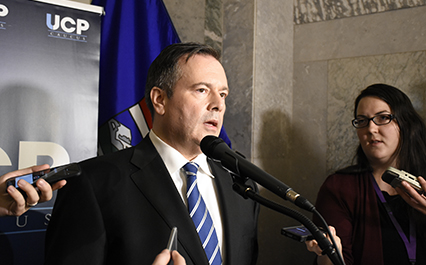Page Content
Education Minister David Eggen fields a question from a reporter following the release of the provincial budget on March 22 at the Alberta legislature.
Budget funds enrolment growth but doesn’t improve classroom conditions
It’s a good budget but it doesn’t improve classroom conditions.
That was the assessment of ATA president Greg Jeffery following the release of the provincial budget on March 22.
On the positive side, the budget provides funding to cover enrolment growth, build new schools and expand the province’s school lunch program. But it scores a “needs improvement” in a number of areas that are of concern to teachers and all Albertans.
“This budget does not do enough to help teachers deal with large class sizes or support students with special learning needs,” Jeffery said in a news release.
The budget will see the government spend $8.4 billion on education, up 1.7 per cent over last year’s budget. Spending on basic instruction will increase by about 2.8 per cent, from $6.04 billion to $6.21 billion. The spending increase is intended to fund student enrolment growth, which is expected to be 15,000 students in the next year.
Jeffery noted that more than 100,000 students have been added to the public education system since 2009 but teaching positions haven’t kept up.
“Funding enrolment growth ensures classroom conditions are maintained but we need at least 2,000 additional teachers to get class sizes back to the accepted standards,” he said.
Albertans also want enhanced funding to improve classroom conditions. ATA polling shows that 80 per cent of Albertans support added funding to reduce class sizes and 90 per cent agree that funding should be increased to better support English language learners and other students with special needs, Jeffery said.
Base grants have only received one small increase in the last seven years and school boards are struggling to keep up with inflationary pressure. Jeffery noted that, while the government is in a tight financial situation, it could generate additional billions by adopting reasonable taxation rates.
“If we adopted B.C.’s tax rates, we would have $11.2 billion in additional revenue and still be tied for the lowest taxes in Canada,” Jeffery said.
Despite the ATA concerns, Education Minister David Eggen described the education budget as positive.
“I’m not sure what budget the ATA is reading, but this is a good news budget for education,” Eggen said. “We’re talking about significant investment in enrolments, in capital, in all aspects of education, so really, they have to make sure they put things into perspective. We have delivered, during still difficult revenue times, a very, very strong K–12 education budget today.”
Eggen noted that he included in the budget a line for $295 million in spending on the Class Size Initiative, and will heed the recommendations of a recent auditor general’s report calling on greater oversight on how this money is spent.
“We will follow all of the recommendations of the auditor general’s in regards to the Class Size Initiative line,” Eggen said. “What we will do is to ensure there is greater transparency and accountability around that.”
The budget also increases spending on the government’s school nutrition program from $10 million to $16 million, which will expand the program to 30,000 students.
The government’s 2018 capital plan includes $393 million for 20 new schools, some of which will primarily serve Indigenous students.
“This is a very proud continuation of the biggest school build in Alberta history,” Eggen said.
Vision lacking
Barbara Silva of the parent group Support Our Students said the budget contains little to celebrate. She called for a review of the province’s education funding model.
“A budget should have a vision and it shouldn’t just be these Band-Aids. What is the long-term vision for how we’re going to keep public education affordable and accessible?” she said.
“I think it’s a very predictable budget for a government one year out from an election,” Silva added. “It’s not inspiring and it’s not impressive; it’s predictable.”
Overall, the budget calls for spending of $56.2 billion and a deficit of $8.8 billion while including a plan to bring the budget into balance by 2023–24. The government’s strategies for balancing the books include continuing an existing salary freeze on non-union public-sector employees and “reaching practical agreements with labour unions to control costs.”
Opposition is opposed
Leaders of the opposition seized on the fact that the budget puts Alberta on track to be $96 billion in debt by 2023, the year the government expects to balance the budget.
 |
| United Conservative Party Leader Jason Kenney shares his thoughts on the provincial budget. |
|
“If there was any indication the NDP was going to change its course and become fiscally responsible that was blown out in a spectacular way in today's NDP budget,” said United Conservative Party leader Jason Kenney.
“This is one part recklessness, one part completely unrealistic projections, higher taxes, massive increases in debt, all of which will burden future generations of Albertans.”
Alberta Liberal Leader David Khan had a similar take.
“Instead of getting off the resource revenue roller coaster, the NDP just bought a ticket for the front seat. Albertans are being asked to hold their breath and hang on for a wild ride,” he said in a news release.
“The NDP is spending without corresponding revenue and spending on the wrong things. The money isn’t going to reduce class sizes. It’s not going to support AISH recipients and vulnerable Albertans.”
